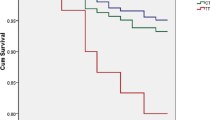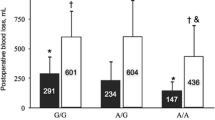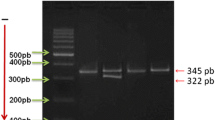Abstract
Endogenous fibrinolysis is a protective mechanism against arterial thrombotic occlusion, which would otherwise lead to permanent tissue damage as acute myocardial infarction (AMI). We aimed to investigate the association of plasminogen activator inhibitor-1 (PAI-1) and tissue plasminogen activator (TPA) genes polymorphisms with myocardial infarction and its outcomes in Egyptian patients. 184 patients with AMI and 184 controls were included in the study. PAI-1 and TPA genes polymorphisms were analyzed by polymerase chain reaction. All patients were followed for AMI complications during their hospitalization. We found a significant association among TPA ID, II genotypes, and I allele and increased risk of AMI by 2.1, 3.2, and 1.9 fold, respectively. Also, the frequencies of PAI-1 4G/4G genotype and 4G allele were significantly increased in patients with AMI as compared to the control group. Furthermore, AMI patients with PAI-1 4G/4G genotype were significantly more likely to have morbidity and mortality complications as compared to AMI patients without complications (P = 0.00 and 0.048, respectively). We concluded that 4G/4G genotype and 4G allele of the PAI-1 gene are associated with risk of AMI and its morbidity. The PAI-1 4G/4G genotype is associated with mortality of AMI. There is also an association between TPA ID, II genotypes, and I allele with increased risk of AMI.
Similar content being viewed by others
References
Hansson, G. K. (2005). Inflammation, atherosclerosis, and coronary artery disease. New England Journal of Medicine, 352, 1685–1695.
Chaer, R. A., Billeh, R., & Massad, M. G. (2004). Genetics and gene manipulation therapy of premature coronary artery disease. Cardiology, 101, 122–130.
American Heart Association: Heart and Stroke Statistical Update. American Heart Association. 2000 ed. Dallas: 2000.
McKay, R. G., Pfeffer, M. A., Pasternak, R. C., Markis, J. E., Come, P. C., Nakao, S., et al. (1986). Left ventricular remodeling after myocardial infarction: A corollary to infarct expansion. Circulation, 74, 693–702.
Brouwer, M. A., van den Bergh, P. J. P. C., Aengevaeren, W. R. M., Veen, G., Luijten, H. E., Hertzberger, D. P., et al. (2002). Aspirin plus coumarin versus aspirin alone in the prevention of reocclusion after fibrinolysis for acute myocardial infarction: Results of the Antithrombotics in the Prevention of Reocclusion In Coronary Thrombolysis (APRICOT)-2 Trial. Circulation, 106, 659–665.
Voetsch, B., & Loscalzo, J. (2004). Genetic determinants of arterial thrombosis. Arteriosclerosis, Thrombosis, and Vascular Biology, 24, 216–229.
Robinson, S. D., Ludlam, C. A., Boon, N. A., & Newby, D. E. (2006). Tissue plasminogen activator genetic polymorphisms do not influence tissue plasminogen activator release in patients with coronary heart disease. Journal of Thrombosis and Haemostasis, 4, 2262–2269.
Mansfield, M. W., Stickland, M. H., & Grant, P. J. (1995). Environmental and genetic factors in relation to elevated circulating levels of plasminogen activator inhibitor-1 in Caucasian patients with non-insulin-dependent diabetes mellitus. Thrombosis and Haemostasis, 74, 842–847.
Dawson, S., Hamsten, A., Wiman, B., Henney, A., & Humphries, S. (1991). Genetic variation at the plasminogen activator inhibitor-1 locus is associated with altered levels of plasma plasminogen activator inhibitor-1 activity. Arteriosclerosis and Thrombosis, 11, 183–190.
Humphries, S. E., Panahloo, A., Montgomery, H. E., Green, F., & Yudkin, J. (1997). Gene-environment interaction in the determination of levels of haemostatic variables involved in thrombosis and fibrinolysis. Thrombosis and Haemostasis, 78, 457–461.
Boersma, E., Pieper, K. S., Steyerberg, E. W., Wilcox, R. G., Chang, W. C., Lee, K. L., et al. (2000). Predictors of outcome in patients with acute coronary syndromes without persistent ST-segment elevation: Results from an international trial of 9461 patients. Circulation, 101, 2557–2567.
Frieldewald, W. T., Levy, R. I., & Fredrickson, D. S. (1972). Estimation of the concentration of low density lipoprotein cholesterol in plasma, without use of the preparative ultracentrifuge. Clinical Chemistry, 18(6), 499–502.
Mansfield, M. W., Strickland, M. H., & Grant, P. J. (1995). Plasminogen activator inhibitor-1 promoter polymorphism and coronary artery disease in non–insulin-dependent diabetes. Thrombosis and Haemostasis, 74, 1032–1034.
Van der Bom, J. G., de Knijff, P., Haverkate, F., Bots, M. L., Meijer, P., de Jong, P. T., et al. (1997). Tissue plasminogen activator and risk of myocardial infarction. The Rotterdam Study. Circulation, 95, 2623–2627.
Swan, H. J. (1989). Acute myocardial infarction: A failure of timely, spontaneous thrombolysis. Journal of the American College of Cardiology, 13, 1435–1437.
Waqas, A., Meera, M., Imran, S., Amina, A. K., Ahmed, S., Umar, K., et al. (2011). Role of tissue plasminogen activator and plasminogen activator inhibitor polymorphism in myocardial infarction. Molecular Biology Reports, 38, 2541–2548.
Hoekstra, T., Geleijnse, J. M., Schouten, E. G., & Kluft, C. (2004). Plasminogen activator inhibitor-type 1: Its plasma determinants and relation with cardiovascular risk. Thrombosis and Haemostasis, 91, 861–862.
Ding, J., Nicklas, B. J., Fallin, M. D., de Rekeneire, N., Kritchevsky, S. B., Pahor, M., et al. (2006). Plasminogen activator inhibitor type 1 gene polymorphisms and haplotypes are associated with plasma plasminogen activator inhibitor type 1 levels but not with myocardial infarction or stroke. American Heart Journal, 152, 1109–1115.
Ridker, P. M., Baker, M. T., Hennekens, C. H., Stampfer, M. J., & Vaughan, D. E. (1997). Alu-repeat polymorphism in the gene coding for tissue- type plasminogen activator (t-PA) and risks of myocardial infarction among middle-aged men. Arteriosclerosis, Thrombosis, and Vascular Biology, 17, 1687–16890.
Steeds, R., Adams, M., Smith, P., Channer, K., & Samani, N. J. (1998). Distribution of tissue plasminogen activator insertion/deletion polymorphism in myocardial infarction and control subjects. Thrombosis and Haemostasis, 79, 980–984.
Onalan, O., Balta, G., Oto, A., Kabakci, G., Tokgozoglu, L., Aytemir, K., et al. (2008). Plasminogen activator inhibitor-1 4G4G genotype is associated with myocardial infarction but not with stable coronary artery disease. Journal of Thrombosis and Thrombolysis, 26, 211–217.
Kholer, H. P., & Grant, P. J. (2000). Plasminogen-activator inhibitor type 1 and coronary artery disease. New England Journal of Medicine, 342, 1792–1801.
Margaglione, M., Cappucci, G., Colaizzo, D., Giuliani, N., Vecchione, G., Grandone, E., et al. (1998). The PAI-1 gene locus 4G/5G polymorphism is associated with a family history of coronary artery disease. Arteriosclerosis, Thrombosis, and Vascular Biology, 18, 152–156.
Iacoviello, L., Burzotta, F., Di Castelnuovo, A., Zito, F., Marchioli, R., & Donati, M. B. (1998). The 4G/5G polymorphism of PAI-1 promoter gene and the risk of myocardial infarction: A meta-analysis. Thrombosis and Haemostasis, 80, 1029–1030.
Crainich, P., Jenny, N. S., Tang, Z., Arnold, A. M., Kuller, L. H., Manolio, T., et al. (2003). Lack of association of the plasminogen activator inhibitor-1 4G/5G promoter polymorphism with cardiovascular disease in the elderly. Journal of Thrombosis and Haemostasis, 1, 1799–1804.
Anderson, J. L., Muhlestein, J. B., Habashi, J., Carlquist, J. F., Bair, T. L., Elmer, S. P., et al. (1999). Lack of association of a common polymorphism of the plasminogen activator inhibitor-1 gene with coronary artery disease and myocardial infarction. Journal of the American College of Cardiology, 34, 1778–1783.
Dawson, S. J., Wiman, B., Hamsten, A., Green, F., Humphries, S., & Henney, A. M. (1993). The two allele sequences of a common polymorphism in the promoter of the plasminogen activator inhibitor-1 (PAI-1) gene respond differently to interleukin-1 in HepG2 cells. Journal of Biological Chemistry, 268, 10739–10745.
Eriksson, P., Kallin, B., van’t Hooft, F. M., Bavenholm, P., & Hamsten, A. (1995). Allele-specific increase in basal transcription of the plasminogen-activator inhibitor 1 gene is associated with myocardial infarction. Proceedings of the National Academy of Sciences USA, 92, 1851–1855.
Panahloo, A., Mohamed-Ali, V., Lane, A., Green, F., Humphries, S. E., & Yudkin, J. S. (1995). Determinants of plasminogen activator inhibitor 1 activity in treated NIDDM and its relation to a polymorphism in the plasminogen activator inhibitor 1 gene. Diabetes, 44, 37–42.
Ye, S., Green, F. R., Scarabin, P. Y., Nicaud, V., Bara, L., Dawson, S. J., et al. (1995). The 4G/5G genetic polymorphism in the promoter of the plasminogen activator inhibitor-1 (PAI-1) gene is associated with differences in plasma PAI-1 activity but not with risk of myocardial infarction in the ECTIM study. Thrombosis and Haemostasis, 74, 837–841.
Takazoe, K., Ogawa, H., Yasue, H., Sakamoto, T., Soejima, H., Miyao, Y., et al. (2001). Increased plasminogen activator inhibitor activity and diabetes predict subsequent coronary events in patients with angina pectoris. Annals of Medicine, 33, 206–212.
Akkus, M. N., Polat, G., Yurtdas, M., Akcay, B., Ercetin, N., Cicek, D., et al. (2009). Admission levels of C-reactive protein and plasminogen activator inhibitor-1 in patients with acute myocardial infarction with and without cardiogenic shock or heart failure on admission. International Heart Journal, 50, 33–45.
Marcucci, R., Brogi, D., Sofi, F., Giglioli, C., Valente, S., Liotta, A. A., et al. (2006). PAI-1 and homocysteine, but not lipoprotein (a) and thrombophilic polymorphisms, are independently associated with the occurrence of major adverse cardiac events after successful coronary stenting. Heart, 92, 377–381.
Corsetti, J. P., Ryan, D., Moss, A. J., Rainwater, D. L., Zareba, W., & Sparks, E. C. (2008). Plasminogen activator inhibitor-1 polymorphism (4G/5G) predicts recurrence in nonhyperlipidemic postinfarction patients. Arteriosclerosis, Thrombosis, and Vascular Biology, 28, 548–554.
Fernandez-Cadenas, I., Alvarez-Sabin, J., Ribo, M., Rubiera, M., Mendioroz, M., Molina, C. A., et al. (2007). Influence of thrombin-activatable fibrinolysis inhibitor and plasminogen activator inhibitor-1 gene polymorphisms on tissue-type plasminogen activator-induced recanalization in ischemic stroke patients. Journal of Thrombosis and Haemostasis, 5, 1862–1868.
Kinlay, S., Schwartz, G. G., Olsson, A. G., Rifai, N., Bao, W., Libby, P., et al. (2009). Endogenous tissue plasminogen activator and risk of recurrent cardiac events after an acute coronary syndrome in the MIRACL study. Atherosclerosis, 206, 551–555.
Lee, C. W., Ahn, J. M., Park, D. W., Kim, Y. H., Hong, M. K., Song, J. K., et al. (2008). Tissue plasminogen activator on admission is an important predictor of 30-day mortality in patients with acute myocardial infarction undergoing primary angioplasty. Atherosclerosis, 196, 327–332.
Soeki, T., Tamura, Y., Shinohara, H., Sakabe, K., Onose, Y., & Fukuda, N. (2002). Plasma concentrations of fibrinolytic factors in the subacute phase of myocardial infarction predict recurrent myocardial infarction or sudden cardiac death. International Journal of Cardiology, 85, 277–283.
Nordenhem, A., & Wiman, B. (1998). Tissue plasminogen activator (tPA) antigenin plasma: Correlation with different tPA/inhibitor complexes. Scandinavian Journal of Clinical and Laboratory Investigation, 58, 475–483.
Wiman, B. (1999). Predictive value of fibrinolytic factors in coronary heart disease. Scandinavian Journal of Clinical and Laboratory Investigation. Supplement, 230, 23–31.
Kluft, C. (1994). Constitutive synthesis of tissue type plasminogen activator and plasminogen activator inhibitor type 1: Conditions and therapeutic targets. Fibrinolysis, 8(Suppl 2), 1–7.
Makalowski, W., Mitchell, G. A., & Labuda, D. (1994). Alu sequences in the coding regions of mRNA: A source of protein variability. Trends in Genetics, 10, 188–193.
Robinson, S. D., Ludlam, C., Boon, N. A., & Newby, D. E. (2005). Tissue plasminogen activator genetic polymorphisms do not influence tissue plasminogen activator releasein patients with coronary artery disease. Journal of Thrombosis and Hemostasis, 4, 2262–2269.
van den Eijnden-Schrauwen, Y., Lakenberg, N., Emeis, J. J., & de Knijff, P. (1995). Alu-repeat polymorphism in the tissue type plasminogen activator gene does not affect basal endothelial t-PA synthesis. Thrombosis and Haemostasis, 74, 1202.
Acknowledgments
This study was funded with the support of Academic Research in Zagazig University Projects, Zagazig University Post Graduate & Research Affairs.
Conflict of interest
No conflict of interest.
Author information
Authors and Affiliations
Corresponding author
Rights and permissions
About this article
Cite this article
El-Aziz, T.A.A., Rezk, N.A. Relation of PAI-1 and TPA Genes Polymorphisms to Acute Myocardial Infarction and its Outcomes in Egyptian Patients. Cell Biochem Biophys 71, 227–234 (2015). https://doi.org/10.1007/s12013-014-0188-x
Published:
Issue Date:
DOI: https://doi.org/10.1007/s12013-014-0188-x




